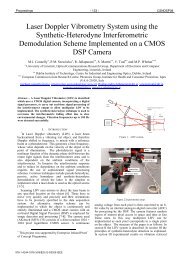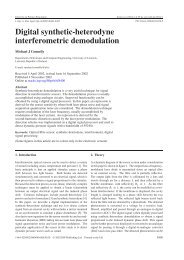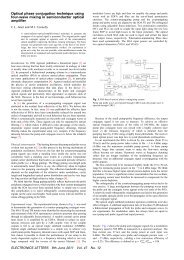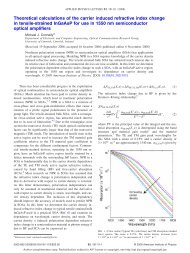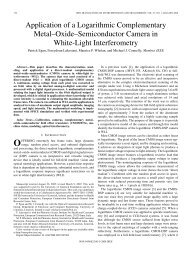Modeling of Semiconductor Optical Amplifier RIN and Phase Noise ...
Modeling of Semiconductor Optical Amplifier RIN and Phase Noise ...
Modeling of Semiconductor Optical Amplifier RIN and Phase Noise ...
You also want an ePaper? Increase the reach of your titles
YUMPU automatically turns print PDFs into web optimized ePapers that Google loves.
NUSOD 2011It is simple to carry out this numerically. In Fig. 3, σ φ is plottedversus the normalised input power. It can be seen that σ φ isquite sensitive to the degree <strong>of</strong> saturation. To our knowledgethe probability density function <strong>of</strong> NRZ-DQPSK r<strong>and</strong>om datain the presence <strong>of</strong> NLPN has not yet been determined <strong>and</strong> so itis not presently possible to obtain an analytical expression forthe bit-error-rate. However it is possible to determine the<strong>Optical</strong> Signal-to-<strong>Noise</strong> Ratio (OSNR) which is given byOSNR = π 8σ(6)2 2φIn Fig. 4, the OSNRs at the outputs <strong>of</strong> a power booster (with noinput noise) <strong>and</strong> a first in-line SOA in a 40 Gb/s DQPSK linkare shown as a function <strong>of</strong> the SOA carrier lifetime. Both SOAinput normalised powers are equal to 0.01. It can be seen thatthere is a serious degradation in the OSNR, particularly at thein-line SOA output, for small carrier lifetimes. Similarsimulations show a similar dependency for increases in thelinewidth enhancement factors <strong>and</strong> scattering losses.Fig. 2: SOA output total phase noise <strong>and</strong> components spectra (centred at theoptical frequency) for a normalised input power <strong>of</strong> 0.1.REFERENCES[1] A.H. Gnauck <strong>and</strong> P.J. Winzer, “<strong>Optical</strong> phase-shift-keyed transmissions,” J.Lightwave Techol., vol 23, pp. 115-130, 2005.[2] X. Wei <strong>and</strong> L. Zhang, “Analysis <strong>of</strong> the phase noise in saturated SOAs forDPSK applications,” IEEE J. Quantum Electron., vol. QE-41, pp. 554-561, 2005.[3] M. Shtaif, B. Tromborg <strong>and</strong> G. Eisenstein, “<strong>Noise</strong> spectra <strong>of</strong> semiconductoroptical amplifiers: relation between semiclassical <strong>and</strong> quantumdescriptions,” IEEE J. Quantum Electron., vol. 34, pp. 869-878, 1998.[4] M.J. Connelly, “Wide-b<strong>and</strong> steady-state numerical model <strong>and</strong> parameterextraction <strong>of</strong> a tensile-strained bulk semiconductor optical amplifier,”IEEE J. Quantum Electron., vol. 43, pp. 47-56, 2007.Fig. 3: SOA output phase noise st<strong>and</strong>ard deviation for input powers rangingfrom 0.01 to 0.1. The receiver b<strong>and</strong>width is 20 GHz.Fig. 1: SOA output total <strong>RIN</strong> <strong>and</strong> components spectra (centred at the opticalfrequency) for a normalised input power <strong>of</strong> 0.1.Fig. 4: OSNR at the output <strong>of</strong> SOA power booster <strong>and</strong> the first in-line amplifieras a function <strong>of</strong> the carrier lifetime for a normalised input power = 0.01. Thereceiver b<strong>and</strong>width is 20 GHz.96


